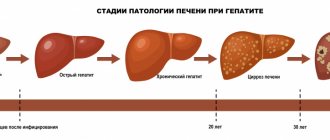Hepatitis B is an infectious liver disease caused by a virus. The pathology is extremely dangerous for the body of any person: in order not to become infected, you need to know the methods of transmission of hepatitis B and take precautions. At the slightest suspicion of infection, you should seek medical help and undergo examination.
General information
Hepatitis B (HVB) is a viral infection of the liver that can cause both acute and chronic illness.
The virus is transmitted through contact with the blood or other body fluids of an infected person. The hepatitis B virus can survive outside the body for at least 7 days. During this time, the virus is still capable of causing infection if it enters the body of a person not protected by the vaccine.
Hepatitis B is one of the global health problems. The virus can lead to the development of chronic liver disease and pose a high risk of death from cirrhosis and liver cancer. WHO estimates that about 2 billion people worldwide have been infected with the virus, and more than 350 million people are sick.
Approximately 780,000 people die each year from this infection—650,000 from chronic cirrhosis and liver cancer and another 130,000 from acute hepatitis B.
Hepatitis B is a serious occupational risk for healthcare workers.
However, the disease can be prevented with the currently available safe and effective vaccine, which has been used successfully since 1982. Its effectiveness in preventing infection and the development of cirrhosis, as well as primary liver cancer due to hepatitis B is 95%, which is why at one time it was called “the first vaccine against cancer.”
Diet and proper nutrition
In the acute period, bed rest and strict dietary nutrition are indicated. The diet for hepatitis B in the acute period is aimed at maximally sparing the organ with adequate nutrition. The acute process requires adherence to Diet No. 5A, in which food is prepared only grated or well-cooked. Soups can be made with finely chopped vegetables. Some dishes are prepared baked, but without a distinct crust. Diet: 5 times a day.
In case of chronic hepatitis B, adherence to diet No. 5 is not necessary, but when drawing up a menu it is worth keeping a guide to it. Experts say that in the chronic stage it is important to adhere to a healthy diet. Proper healthy eating involves consuming enough proteins, fats, carbohydrates and beneficial microelements
What should you not eat?
It is prohibited to use:
- fresh and rye bread;
- products made from butter or puff pastry;
- millet and all legumes;
- broths;
- fatty meats, fried meats, sausages, smoked meats;
- offal and canned food;
- cream and fat cottage cheese;
- mushrooms, legumes, pickled vegetables, turnips, radishes, cabbage, sorrel, garlic, onions;
- fruits that are sour and rich in fiber;
- cocoa, coffee, chocolate, carbonated drinks.
Allowed foods
Dishes and food allowed for consumption in acute and chronic forms of hepatitis B:
- yesterday's bread;
- unleavened pastries with various fillings;
- biscuits, marshmallows;
- soups cooked in water, milk, low-fat broth;
- chicken ham and sausages;
- from meat - chicken, veal, rabbit;
- from fish - pollock, hake, blue whiting;
- steamed and baked omelettes;
- steamed meatballs and cutlets;
- milk, low-fat fermented milk products;
- all types of cereal porridges;
- vermicelli and pasta;
- vegetable salads seasoned with sunflower oil or low-fat sour cream;
- vegetable fats;
- Bee Honey;
- fruits and vegetables in baked, boiled, raw form;
- non-acidic vegetable, berry and fruit juices;
- green tea.
With hepatitis, the processes of bile formation are disrupted, which leads to impaired absorption of vitamin K in the gastrointestinal tract and its deficiency. Foods containing vitamin K:
- parsley,
- watercress,
- basil,
- cilantro,
- cabbage (broccoli, Chinese cabbage, white cabbage),
- celery root,
- prunes,
- avocado,
- cashews, pine nuts.
Chance of getting sick
In areas with a high prevalence of HBV, the virus is most often transmitted from mother to child during childbirth or from person to person in early childhood. Transmission of infection during the perinatal period or early childhood can also lead to the development of chronic infections in more than one third of those infected.
Hepatitis B is also spread through cutaneous or mucosal exposure to infected blood or various body fluids, as well as through saliva, menstrual, vaginal secretions and seminal fluid. Sexual transmission of hepatitis B can occur.
Transmission of the virus can also occur through the reuse of syringes and needles, either in health care settings or among injection drug users. In addition, infection may occur during medical, surgical or dental procedures, tattooing, or the use of razor blades or similar objects contaminated with infected blood.
Despite the fact that Russia is a country with a moderate rate of hepatitis B infection, the risk of becoming infected with this virus throughout life for each of us is 20-60%.
Does hepatitis B infection always lead to illness?
Maintaining personal hygiene rules - preventing hepatitis
Almost always, infection leads to the development of the disease. The exception is cases when a vaccination has been given. Also, people who have already had this disease will not get sick.
If the baby was born from a mother suffering from this disease, he is given immunoglobulin in the maternity hospital, specially designed for such cases. This will protect the child by 85 - 95%. Such a high percentage of protection will be provided only if the child subsequently receives the vaccination itself on time.
This immunoglobulin is administered to adults. For example, employees of medical institutions, when it becomes known that a doctor is infected with hepatitis B. It should be noted that vaccination, which was done in advance, gives a guaranteed result.
After infection, people develop an acute form of the disease. If the patient was severely weakened, or the child was infected, then the acute stage most likely will not develop. And the disease will develop into a sluggish chronic form.
Re-infection with hepatitis B
If recovery from an illness is confirmed by laboratory testing, re-infection is almost completely excluded.
Symptoms
The incubation period for hepatitis B lasts on average 75 days, but can increase to 180 days. The virus can be detected 30-60 days after infection.
During the acute infection stage, most people do not experience any symptoms. However, for some, acute hepatitis B infection may cause symptoms that last several weeks, including yellowing of the skin and eyes (jaundice), dark urine, extreme tiredness, nausea, vomiting, and abdominal pain. A relatively small number of patients with acute hepatitis may develop acute liver failure, often leading to death (fulminant hepatitis).
In some people, the hepatitis B virus can also cause a chronic liver infection that can later develop into cirrhosis or liver cancer.
Complications after an illness
Hepatitis B is dangerous because of its consequences: it is one of the main causes of liver cirrhosis and the main cause of hepatocellular cancer of the liver. The likelihood that hepatitis B virus infection will become chronic depends on the age at which a person acquires the infection. Children most likely to develop chronic infections are those infected before the age of six:
- chronic infections develop in 80-90% of children infected during the first year of life;
- Chronic infections develop in 30-50% of children infected before the age of six.
- 15-25% of adults who become chronically infected during childhood die from liver cancer or cirrhosis.
Among adults:
- Chronic infections occur in <5% of infected, otherwise healthy adults;
- 20%-30% of chronically infected adults develop cirrhosis and/or liver cancer.
The probability of complete recovery from chronic hepatitis B is very low - about 10%. But a state of relative health (remission), in which the virus practically does not bother the patient, can be achieved in more than 80% of cases.
Our phone numbers:
Human viral hepatitis represents a traditionally difficult global problem that is still far from being resolved. According to WHO estimates, hundreds of millions of people are infected with viral hepatitis in different countries of the world. This significantly exceeds the prevalence of HIV infection but, at the same time, has not attracted due attention. At the present stage, as in an earlier period, the high epidemic potential of all known viral hepatitis - A, B, C, D, E, G - remains high.
A completely unfavorable epidemiological situation regarding viral hepatitis has developed in the former Soviet Union. The number of patients with acute viral hepatitis reaches 1 million per year.
In the light of modern knowledge, the group of human viral hepatitis, called hepatitis A, B, C, D, E, G, includes nosologically independent infectious diseases, the characteristics of which are very diverse. The unifying principle is the hepatotropic nature of the pathogens, which determines the development of selective liver damage. Viral hepatitis A, B, C, D, E, G differ in all aspects - taxonomic affiliation of viruses, mechanism of infection and routes of transmission, pathogenesis and immunogenesis, clinical manifestations, severity and outcomes, likelihood of chronicity and malignancy, specific diagnostic criteria, different therapy and prevention programs.
The current stage is called the “golden era” of studying the problem of viral hepatitis. Thanks to the use of methods of virology, molecular biology, genetic engineering, in particular recombinant technology, new horizons for understanding the problem and its further study have opened up.
The Nobel Prize-winning discovery of the “Australian antigen” was the first in a chain of brilliant research that made the unknown known.
The causative agents of viral hepatitis - A, B, C, D, E, G - were discovered. The long-standing dream of clinicians about the separate specific diagnosis of viral hepatitis of different etiologies was realized not by exclusion or indirect signs, but on the basis of direct studies using highly specific and highly sensitive test systems . The use of new research methods has shown that the “hepatitis alphabet” is far from being exhausted. There remains a niche of viral hepatitis, neither A, nor B, nor C, nor D, nor E, nor G, caused by other pathogens.
Types of hepatitis viruses.
Hepatitis A
Of all the fairly numerous forms of viral hepatitis, hepatitis A is the most common. Although this disease is characteristic mainly of third world countries with poor hygiene and sanitation, isolated cases or outbreaks of hepatitis A can occur even in the most developed countries.
Hepatitis A virus is transmitted by the fecal-oral route. The most common route of transmission of hepatitis A virus is through close household contact between people and consumption of food or water contaminated with fecal material.
One of the most important factors on which the clinical manifestations of hepatitis A depend is age. Unlike adults, children do not have the “classic” picture of hepatitis A. Moreover, in young children, hepatitis A can be asymptomatic. The frequency of occurrence and severity of symptoms of the disease increases with age, so the icteric form of hepatitis A is characteristic of almost all adult patients. Elderly patients are more likely to develop a severe form of the disease, and they are more likely to develop severe complications of hepatitis A. Patients over 40 years of age are more likely to require hospitalization, and the mortality rate among them, compared to other age groups, is also higher. In typical cases, the clinical course of hepatitis A has four stages: the incubation period, the prodromal phase, the icteric phase and the convalescent period. An infected patient releases the virus in the initial stages of the disease, and the infection is transmitted to others long before the development of clinical symptoms. After the most contagious incubation period of 15 to 50 days, most patients with hepatitis A begin to experience prodromal symptoms of the disease. This is followed by the clinical manifestation of the disease, which is characterized by great variability of symptoms. As with other viral infections, the prodromal symptoms of hepatitis A are usually nonspecific, with patients experiencing weakness, gastrointestinal distress (including food aversions, diarrhea, and vomiting), and flu-like symptoms such as headache, chills, and fever. In addition, respiratory problems, muscle weakness, skin rashes and joint pain may often occur. The appearance of dark urine and uncolored feces at the end of the prodromal period are important signs indicating infection with the hepatitis A virus and usually cause the patient to seek medical help. At the end of the acute period of the disease, which usually lasts several weeks, most patients recover. However, in some cases, a relapse of the disease, the development of cholestatic jaundice or fulminant hepatitis may occur26. Patients who have recovered from the disease have long-term, possibly lifelong, immunity to hepatitis A. Long-term and persistent immunity to the disease is developed only after hepatitis.
Hepatitis B
This rather severe and common form of hepatitis is also called serum hepatitis. This name is due to the fact that infection with the hepatitis B virus can occur through the blood, and in an extremely small dose. The hepatitis B virus can be transmitted sexually, through injections with non-sterile syringes from drug addicts, or from mother to fetus. Hepatitis B is characterized by liver damage and occurs in different forms: from carriage to acute liver failure, cirrhosis and liver cancer. From the moment of infection to the onset of the disease, 50-180 days pass. In typical cases, the disease begins with fever, weakness, joint pain, nausea and vomiting. Sometimes rashes appear. The liver and spleen become enlarged. There may also be darkening of the urine and discoloration of the stool.
A specific reaction for diagnosing hepatitis B, or its carriage, is the detection of HbsAg. Treatment requires an integrated approach and depends on the stage and severity of the disease. The main drug was the immune drug - Interferon and its analogues. Hormones, hepatoprotectors, and antibiotics are also used. Various types of vaccines are used to prevent hepatitis B virus infection. To build immunity, the vaccination is repeated one month and six months after the first injection.
Hepatitis C
Hepatitis C is the most severe form of viral hepatitis, which is also called post-transfusion hepatitis. This means that they contracted it after a blood transfusion. This is due to the fact that testing of donor blood for the hepatitis C virus began only a few years ago. Quite often, infection occurs through syringes among drug addicts. Sexual transmission is possible from mother to fetus.
The greatest danger is the chronic form of this disease, which often develops into cirrhosis and liver cancer.
A chronic course develops in approximately 70-80% of patients. The combination of hepatitis C with other forms of viral hepatitis dramatically worsens the disease and can lead to death.
Hepatitis D
The causative agent of delta hepatitis has a defect, which means that the virus cannot reproduce independently in the human body; it requires the participation of a helper virus. This helper is the hepatitis B virus. This tandem gives rise to a rather serious disease. Doctors call this “union” a superinfection. Most often, infection occurs through blood transfusions, through syringes from drug addicts. Sexual transmission is possible from mother to fetus. All persons infected with the hepatitis B virus are susceptible to hepatitis D. The risk group includes hemophiliacs, drug addicts, and homosexuals.
Often, infection with hepatitis B and D viruses occurs simultaneously. From the moment of infection to the development of the disease, it takes 1.5-6 months, as with hepatitis B. The clinical picture and laboratory data are the same as for hepatitis B.
However, with mixed infection, severe forms of the disease predominate, often leading to liver cirrhosis. Doctors agree that the prognosis for this disease is often unfavorable. Treatment is the same as for hepatitis B.
Hepatitis E
Previously (before the detection of the hepatitis E virus), the disease, together with hepatitis C, D, G, was included in the group of so-called “neither A nor B” hepatitis. The mechanism of infection, like hepatitis A, is fecal-oral. That is, the disease is transmitted from a sick person who excretes the virus in their feces. Infection often occurs through water. As with hepatitis A, the prognosis is favorable in most cases. The exception is women in the last three months of pregnancy, in whom mortality reaches 9-40% of cases. Susceptibility to viral hepatitis E is universal. Mostly young people aged 15-29 years old become ill. The disease is especially common in countries with hot climates and extremely poor water supplies.
From the moment of infection to the onset of the disease, 14 to 50 days pass. Hepatitis E begins gradually with indigestion, deterioration in general health, and less often with a short rise in temperature. Unlike hepatitis A, the appearance of jaundice does not improve the health of patients.
After 2-4 weeks from the onset of the disease, a reverse development of symptoms and recovery is observed. Unlike other types of viral hepatitis, severe liver and kidney damage is observed in severe forms of hepatitis E. With hepatitis E, more often than with hepatitis A, moderate and severe forms of the disease are observed. Hepatitis E is characterized by a severe course in pregnant women in the second half of pregnancy with a high number of deaths. Fetal death occurs in almost all cases. Hepatitis E is not characterized by a chronic course and viral carriage. Treatment and prevention as for hepatitis A.
HepatitisG
Hepatitis G (Hepatitis G) is widespread. In Russia, the frequency of detection of the pathogen ranges from 2% in Moscow to 8% in Yakutia. According to the figurative expression of English doctors, hepatitis G is the younger brother of hepatitis C. Indeed, they have a lot in common. Hepatitis G is transmitted in the same way: through blood. This is reflected in the widespread prevalence of the disease among drug addicts. Infection also occurs during blood transfusions and parenteral interventions. Sexual transmission and vertical transmission from an infected mother to a child are possible.
In terms of clinical manifestations, hepatitis G also resembles hepatitis C. However, it is not characterized by the progression of the infectious process inherent in hepatitis C with the development of cirrhosis and cancer. As a rule, the acute infectious process is mild and asymptomatic. The main marker for diagnosing hepatitis G is the PCR (polymerase chain reaction) method.
The outcomes of acute hepatitis G can be: recovery, the formation of chronic hepatitis or prolonged carriage of the virus. Combination with hepatitis C can lead to cirrhosis.
Routes of infection, diagnosis and symptoms of hepatitis.
Hepatitis viruses enter the human body in two main ways.
A sick person can excrete the virus in their feces, after which it enters the intestines of other people with water or food. Doctors call this mechanism of infection fecal-oral. It is characteristic of the hepatitis A and E viruses. Thus, hepatitis A and hepatitis E arise mainly due to poor personal hygiene, as well as imperfect water supply systems.
This explains the greatest prevalence of these viruses in underdeveloped countries.
The second route of infection is human contact with infected blood. It is characteristic of hepatitis B, C, D, G viruses.
The greatest danger, due to the prevalence and severe consequences of infection, are the hepatitis B and C viruses.
Here are the situations in which infection most often occurs: - Donor blood transfusion. Worldwide, on average, 0.01 - 2% of donors are carriers of hepatitis viruses, so currently donor blood is tested for the presence of hepatitis B and C viruses before transfusion to the recipient. The risk of infection increases in persons who require repeated transfusions of blood or its products.
- Using the same needle by different people greatly increases the risk of contracting hepatitis B, C, D, G. This is the most common route of infection among drug addicts.
- Viruses B, C, D, G can be transmitted through sexual contact. Hepatitis B is most often transmitted sexually. It is believed that the likelihood of contracting hepatitis C in spouses is low.
- The route of infection from mother to child (doctors call it “vertical”) is not observed so often. The risk increases if a woman has an active form of the virus or suffered acute hepatitis in the last months of pregnancy. The likelihood of infection of the fetus increases sharply if the mother, in addition to the hepatitis virus, has HIV infection. The hepatitis virus is not transmitted through mother's milk.
Hepatitis B, C D, G viruses are transmitted through tattooing, acupuncture, and ear piercing with unsterile needles. In 40% of cases, the source of infection remains unknown.
Complications of viral hepatitis can include functional and inflammatory diseases of the biliary tract and hepatic coma, and if the disruption of the biliary tract is treatable, then hepatic coma is a formidable sign of the fulminant form of hepatitis, ending in death in almost 90% of cases. In 80% of cases, the fulminant course is caused by the combined effect of hepatitis B and D viruses.
Hepatic coma occurs due to massive necrosis (necrosis) of liver cells. The breakdown products of the liver tissue enter the blood, causing damage to the central nervous system and the extinction of all vital functions.
Recovery from viral hepatitis is long-term. Often, the disease takes on protracted forms. Some patients infected with the hepatitis B, C, D virus do not get sick themselves, but being carriers, they pose a danger in terms of infecting others. A very unfavorable outcome of acute hepatitis is its transition to the chronic stage, mainly with hepatitis C.
Chronic hepatitis is dangerous because the lack of adequate treatment inevitably leads to cirrhosis and sometimes liver cancer. In this regard, doctors consider hepatitis C to be the most serious disease: In 70-80% of cases, its acute form becomes chronic, although there may be no external signs of the disease. Moreover, the majority of patients with acute hepatitis C experience the phenomenon of “imaginary recovery”, in which the data of biochemical blood tests return to normal. This phenomenon lasts from several weeks to several months or even years, and patients may mistake this period for recovery. This dictates the need for long-term and regular monitoring of patients and mandatory specific therapy. Hepatitis C is not unreasonably compared in severity to AIDS.
But the most severe course of hepatitis is caused by a combination of two or more viruses, for example B and D or B and C. Even B+D+C is found. In this case, the prognosis is extremely unfavorable. Often, the signs of chronic viral hepatitis are mild, which allows a person to ignore the disease for the time being. Often, obvious clinical manifestations of the disease are detected already at the stage of cirrhosis.
Cirrhosis occurs in approximately 20% of people with hepatitis C. Hepatitis B with or without hepatitis D can also cause this complication. The presence of cirrhosis creates obstacles to normal blood flow in the liver. The blood is forced to find additional bypass routes, which leads to dilation of blood vessels in the esophagus and stomach.
These dilated blood vessels are called varicose veins; they stretch and can become a source of bleeding, requiring emergency medical attention. Another problem associated with the development of liver cirrhosis is ascites (accumulation of fluid in the abdominal cavity), which is externally manifested by an increase in the size of the abdomen. Sometimes, patients with cirrhosis develop liver cancer, which in the early stages can be treated with medications or surgery. If cirrhosis of the liver has formed, it cannot be eliminated, even if the inflammation of the liver has already passed. Therefore, treatment for viral hepatitis should be started as early as possible!
Treatment and prevention of hepatitis.
To protect yourself from hepatitis infection, you must follow simple rules.
You should not drink unboiled water, always wash fruits and vegetables, and do not neglect heat treatment of products. This way you can prevent infection with hepatitis A, the transmission of which is associated with food contamination from the feces of a sick person. The great rule “Wash your hands before eating” is a guarantee of health in this case as well.
In general, contact with other people's body fluids should be avoided. To protect against hepatitis B and C - primarily with blood.
Blood in microscopic quantities can remain on razors, toothbrushes, and nail scissors. You should not share these items with other people.
Medical institutions take measures to prevent hepatitis infection. However, if you had an endoscopy or dental treatment ten to fifteen years ago, when the fight against hepatitis was not yet carefully organized, you need to get checked. There is still a small risk of infection today.
Never share syringes and needles when taking drugs. Never perform piercings or tattoos with non-sterile equipment. Remember - the hepatitis virus is very tenacious and, in contrast to the AIDS virus, persists in the external environment for a long time (sometimes up to several weeks). Invisible traces of blood can even remain on straws used when using cocaine, so in this case, you should be wary of contamination.
Hepatitis B is most often transmitted through sexual contact, but infection with hepatitis C is also possible. It is especially necessary to take precautions during sex during menstruation and anal intercourse, however, oral sex can also be dangerous.
Hepatitis is also transmitted in the so-called “vertical” way - from mother to child during pregnancy, childbirth, and breastfeeding. With proper medical support, you can try to avoid infection of the baby - this will require careful adherence to hygiene rules and taking medications.
However, the route of hepatitis infection very often remains unknown. To be completely calm, you need to get vaccinated.
Currently, healthcare practice has effective vaccines only against hepatitis A and B. Intensive research is underway to develop a vaccine against hepatitis C, but it is at an early stage, because The high variability of the virus and the lack of an effective protective antibody response after hepatitis C infection make these studies difficult. In this regard, timely treatment of hepatitis C can prevent the development of severe progressive changes in liver tissue, which will certainly improve the patient’s quality of life.
It is not difficult to protect yourself from hepatitis A - one vaccination provides protection for more than 1 year. Second dose after 6 - 12 months. after primary provides long-term protection. For adults, the vaccine is administered in a dose of 0.5 ml into the deltoid muscle. Course - 3 vaccinations according to the schedule of 0, 1 and 6 months. Children are injected with 0.25 ml into the deltoid muscle twice with an interval of 1 month. As planned, medical workers, staff of preschool institutions, and service sector workers (primarily those employed in public catering establishments, water supply and sewerage facilities) are vaccinated against hepatitis A; traveling to regions and countries hyperendemic for hepatitis A (Middle East, Africa, Latin America, Indonesia); In the event of accidents at water supply and sewerage facilities (wastewater entering the water supply network), the population that used this water main is subject to vaccination against hepatitis A.
Since 1981, more than 1 billion doses of hepatitis B vaccines have been used worldwide with excellent safety and efficacy indicators; the vaccine is 95% effective in preventing the development of chronic carriage of the hepatitis B virus. The hepatitis B vaccine is the first anti-cancer vaccine, since chronic carriers of the hepatitis B virus are at high risk of mortality due to cirrhosis and liver cancer. Because of the critical importance of hepatitis B vaccine, the World Health Assembly recommended in 1992 that all countries should include hepatitis B virus vaccination in their national immunization schedules. To date, 100 countries have introduced hepatitis B vaccination into their national immunization schedules. In addition, adolescents are vaccinated in many industrialized countries. In some US states, newborns are vaccinated without exception.
The hepatitis B vaccine has been included in the national calendar of preventive vaccinations since 1996.
According to the National Preventive Vaccination Calendar, the first vaccination against viral hepatitis B is given to newborns in the first 12 hours of life, the second at the age of 1 month, and the third at 6 months.
Children born to mothers who are carriers of the hepatitis B virus or who are sick with viral hepatitis B in the third trimester of pregnancy are vaccinated against viral hepatitis B according to the schedule of 0-1-2-12 months.
Post-vaccination reactions when using the vaccine are rare. In 3.5-5% of cases, slight passing local pain, erythema and induration at the injection site are possible, as well as a slight increase in temperature, complaints of malaise, fatigue, joint pain, muscle pain, headache, dizziness, nausea. These reactions develop mainly after the first two injections and disappear after 2-3 days. Particularly sensitive people may develop immediate allergic reactions, so the vaccinated person requires medical supervision for 30 minutes.
Contraindications: hypersensitivity to yeast and other components of the drug, acute infectious and non-infectious diseases, chronic diseases in the acute stage (immunization is carried out no earlier than a month after recovery (remission)), decompensated forms of diseases of the cardiovascular system and lungs, pregnancy.
Conclusion.
Viral hepatitis is a common and dangerous infectious disease.
They can manifest themselves differently, but among the main symptoms are jaundice and pain in the right hypochondrium.
To diagnose hepatitis, you need to do a blood test, urine test, and in difficult cases, a liver biopsy.
Of all forms of viral hepatitis A is the most common. From the moment of infection to the appearance of the first signs of the disease, 7 to 50 days pass. Most often, the onset of the disease is accompanied by a rise in temperature, and may resemble the flu.
Most cases result in spontaneous recovery and do not require active treatment. In severe cases, droppers are prescribed to eliminate the toxic effect of the virus on the liver.
The hepatitis B virus is transmitted sexually, through injections with non-sterile syringes from drug addicts, and from mother to fetus.
In typical cases, the disease begins with fever, weakness, joint pain, nausea and vomiting.
Sometimes rashes appear. The liver and spleen become enlarged. There may also be darkening of the urine and discoloration of the stool.
Hepatitis C is the most severe form of viral hepatitis, which is also called post-transfusion hepatitis. This means that they contracted it after a blood transfusion. This is due to the fact that testing of donor blood for the hepatitis C virus began only a few years ago. Quite often, infection occurs through syringes among drug addicts. Sexual transmission is possible from mother to fetus.
The greatest danger is the chronic form of this disease, which often develops into cirrhosis and liver cancer.
A chronic course develops in approximately 70-80% of patients. The combination of hepatitis C with other forms of viral hepatitis dramatically worsens the disease and can lead to death. Hepatitis D is a “companion disease” that complicates the course of hepatitis B.
Hepatitis E is similar to hepatitis A, but it starts gradually and is more dangerous for pregnant women. The last in the hepatitis family, G, is similar to C, but less dangerous.
Treatment
Medical care for hepatitis B is aimed at maintaining comfort and a rational combination of nutrients, including replacing fluid lost as a result of vomiting and diarrhea. People with chronic hepatitis B who need treatment can be treated with medications, including oral antivirals (such as tenofovir and entecavir) and interferon injections. Treatment of hepatitis B may slow the progression of cirrhosis, reduce the incidence of hepatocellular carcinoma, and improve long-term survival. However, in many resource-poor areas, access to such treatment is difficult.
Liver cancer is almost always fatal and often occurs in people who are in their prime productive years and are providing for their families. In developing countries, most people with liver cancer die within months of diagnosis. In high-income countries, surgery and chemotherapy can prolong life by several years. Patients with cirrhosis sometimes undergo liver transplants, with varying degrees of success.
The first signs in women and men
The first signs of hepatitis B:
- Weakness, slight fever, headache, lack of appetite.
- Then there are signs caused by indigestion: nausea, abdominal pain, vomiting. Impaired bilirubin metabolism causes dark urine and discolored stool.
- After these symptoms begin to gradually disappear, jaundice develops - a corresponding staining of the skin and sclera of the eyes.
Most patients show no signs of the disease. Therefore, doctors consider any person as potentially infected, observing the necessary precautions during medical procedures and using disposable instruments.
Effectiveness of vaccination
As of 2013, 183 Member States were vaccinating infants against hepatitis B as part of their national vaccination schedules, and 81% of children had received hepatitis B vaccination. This represents significant progress compared to 31 countries in 1992, when the World Assembly Health Council adopted a resolution recommending global vaccination against hepatitis B.
Additionally, as of 2013, 93 Member States have introduced hepatitis B dose provision at birth. Since 1982, more than one billion vaccine doses have been used worldwide.
In many countries where typically 8% to 15% of children had chronic hepatitis B virus infection, vaccination has reduced rates of chronic infection among immunized children to less than 1%.
Vaccines
Expert opinion
CM. Harit
Professor, Doctor of Medical Sciences, Head of the Department of Prevention of Infectious Diseases, Research Institute of Children's Infections
Hepatitis B is contracted everywhere equally through blood (everyone) and through sexual contact (teenagers and adults). A drop of blood is so small that you cannot see it and it is already contagious, so families become infected through toothbrushes, razors, etc...
The basis for preventing hepatitis B is vaccination. WHO recommends that all infants should receive hepatitis B vaccine as soon as possible after birth, preferably within 24 hours. If a child does not receive this vaccination in the maternity hospital, the risk of infection increases significantly, and if a newborn is infected during the neonatal period, liver cirrhosis develops in adolescence or early adulthood.
The dose given at birth should be followed by two or three subsequent doses to complete the vaccination series. In most cases, one of the following two options is considered optimal:
- A three-dose hepatitis B vaccination regimen, in which the first dose (of monovalent vaccine) is given at birth and the second at 1 month of age, which is also very important, since this dose minimizes the risk of infection of the child from infected family members. The third dose (of monovalent or combination vaccine) is administered at 6 months, simultaneously with the DTP vaccine, which determines the duration of immunity against hepatitis B.
- A four-dose regimen in which the first dose of monovalent vaccine given at birth is followed by 3 doses of monovalent or combination vaccine, usually given along with other vaccines as part of routine childhood immunization, is indicated for children born to mothers infected or with hepatitis B.
After a full series of vaccinations, more than 95% of infants, children of other age groups and young adults develop protective antibody levels. Protection lasts for at least 20 years and possibly a lifetime.
More about vaccines









